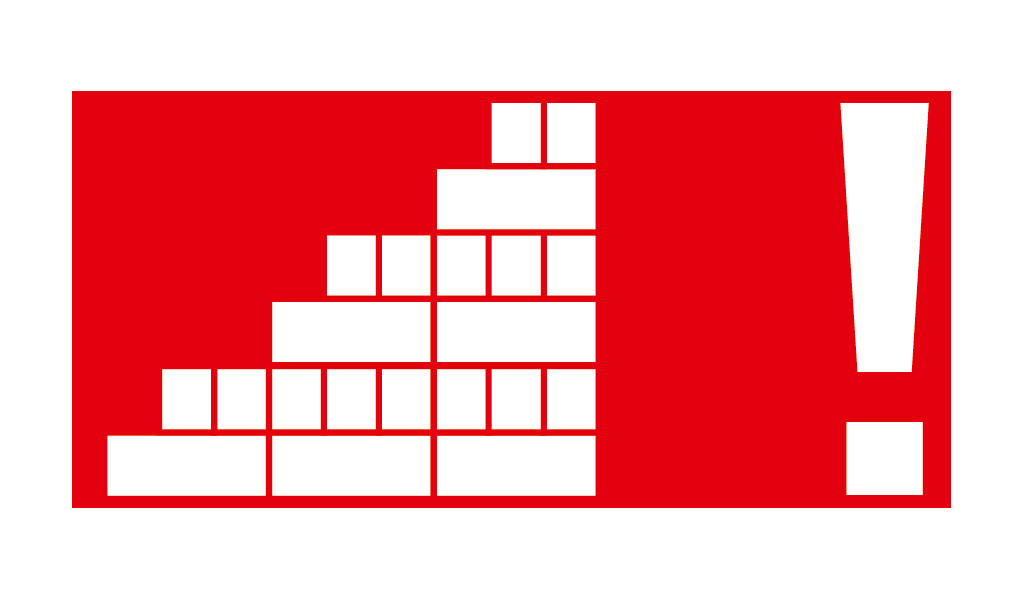Brick Processing Instructions
(Klik hier voor nederlandse versie: Verwerken van bakstenen)
The ten most important tips for the processing of bricks and clinker bricks
We have summarised the ten most important tips for processing bricks and clinker bricks for you here.
- Order bricks and facing bricks and mortar for contiguous building sections in good time and store them off the ground.
- Always process bricks from at least four packs at the same time (cross-mixing).
- Pre-wet highly absorbent bricks.
- Bricks should be laid on a full bed of mortar. Overlaps must be maintained.
- Immediately after the brick is laid, excess mortar should be struck off the external face of the work. Remove dry mortar residues with a wooden spatula or brush. For certain joint profiles the mortar is left to stiffen slightly and then tooled.
- Never brick up in frosty conditions. Protect fresh masonry and material from frost. Do not use antifreeze!
- Protect fresh masonry from dirt.
- Protect fresh masonry from rain and sun, keep water away from masonry.
Ordering - Storage - Masonry - Joints: our processing instructions in detail
Ordering
Many bricks have delivery times of several weeks or more: If possible, order all the bricks required for the construction, but at least for connected construction phases. This will help you avoid colour differences, because brick is a building material made from natural raw materials and different production batches can have different colour nuances.
Storage
Carefully unload facing bricks, store them off the ground, protect them from dirt and weather. Cover open brickwork when work is interrupted. Drain rainwater from the carcass and drain weather-exposed carcass ceilings.
Walls
Do not lay bricks at temperatures below + 5 °C. Protect masonry and material from frost. Do not use antifreeze for the mortar.
Use mortar according to DIN 1053, part 1, table A1, mortar group II or II a. Factory dry mortars are prepared on site by adding mixing water. Add water according to the information on the container. Mortar must be well mixed and processed within one hour. Chemical additives are not permitted.
Bricks
Remove bricks from at least 4 packs at the same time and mix them crosswise to achieve a natural play of colour. Absorbent facing bricks should be pre-wet, especially in dry weather. Do not beat but rather saw off parts of bricks when necessary. Protect fresh brickwork from extreme weather conditions by covering it! Do not lay bricks at temperatures (day and night) below + 5 °C.
Joints
Flush joint profiles: Joints are smoothed immediately after the mortar has set (thumb test). Purpose-made metal jointing tools are available, but off-cuts of metal or rubber tubing are frequently used. When the brick is properly set in position excess mortar is skimmed off at the surface.
Subsequent jointing: Remove coarse soiling. Pre-clean brick surfaces dry, in particular clean the joints from all mortar residues. Clean with water: Pre-wet until saturated with water from bottom to top and clean with a root brush from bottom to top. Only clean with commercial cleaning agents (pH value 3 - 7) in case of heavy soiling. Do not use hydrochloric acid. Rinse generously with clear water. Do not work on subsequent joints in excessively dry weather, strong sunlight and wind.
Use building site mortar or factory dry mortar of groups II, IIa. The jointing mortar must be moist to formable and worked within one hour. Do not use at temperatures below + 5 °C. The use of antifreeze is not permitted, as this may cause increased efflorescence
If you have any questions, please do not hesitate to contact us by phone 0049 5942 9210 0 or info@deppe-backstein.de.
